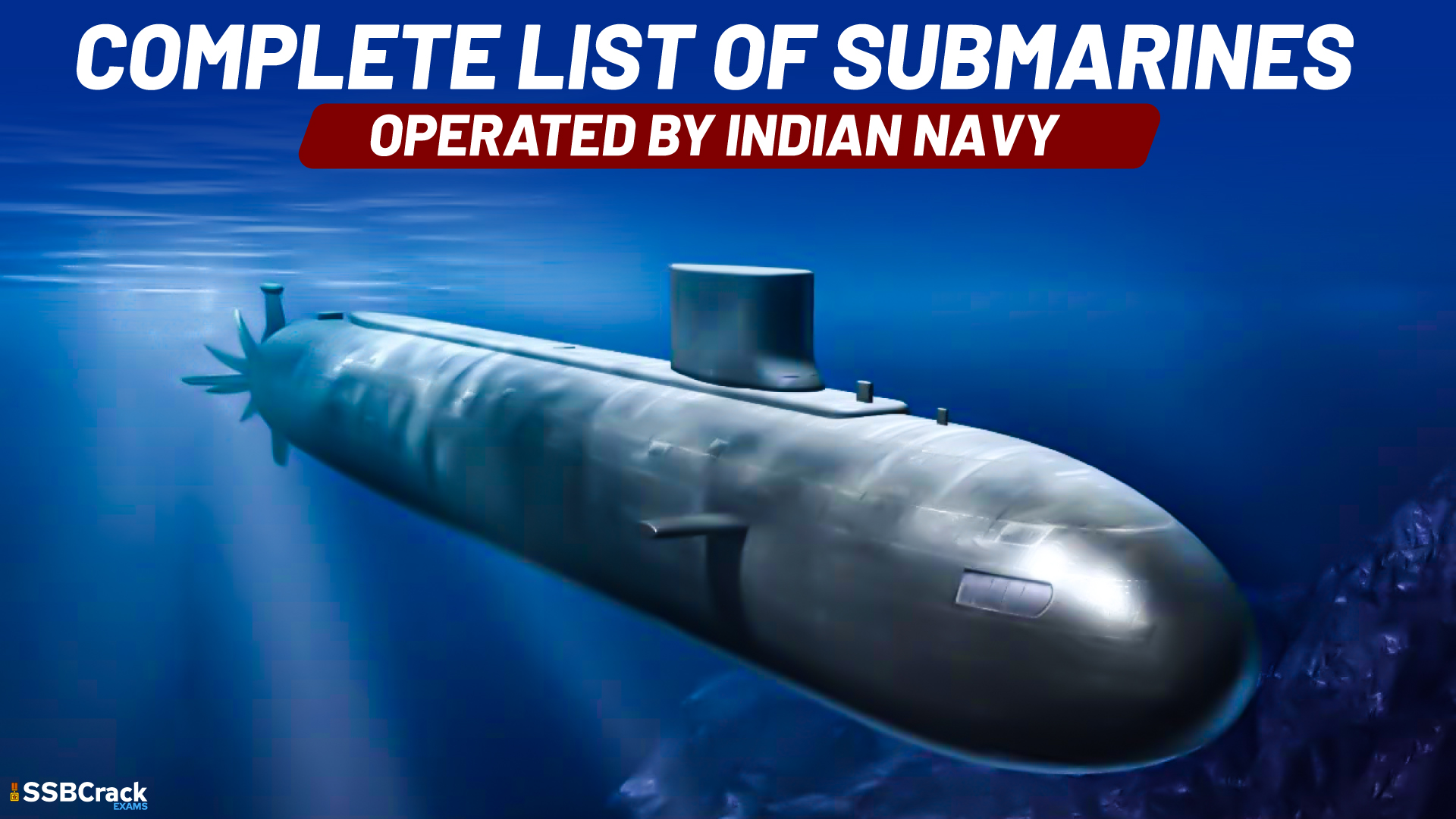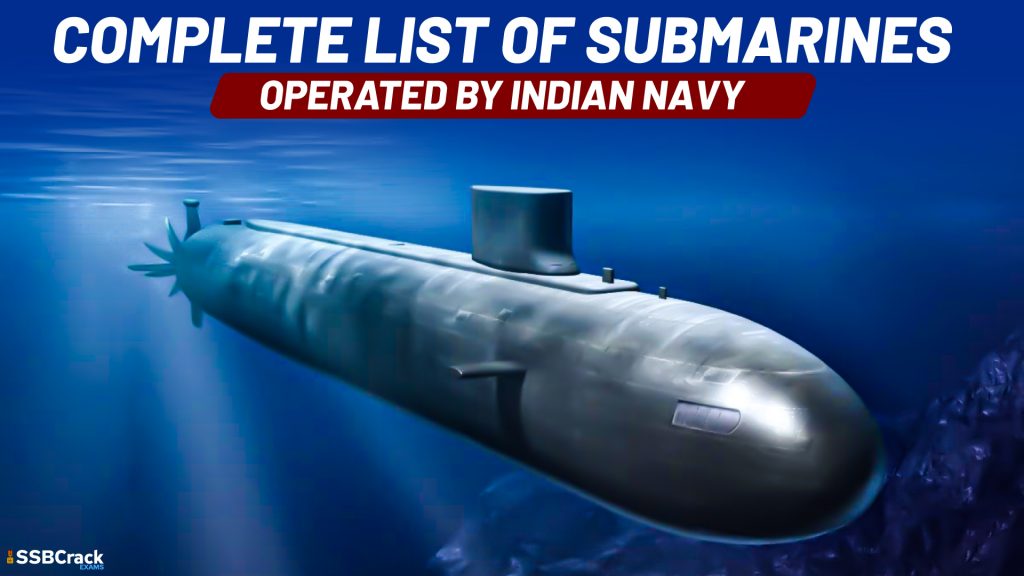The Indian Navy has an extensive collection of submarines. A submarine is essentially a vessel that is capable of propelling itself under water. Submarines or ‘’subs’’ are streamlined and are often armed with missiles or nuclear weapons.
Why are submarines used in the armed forces?
Attack to a nations’ territory is not just limited to land and air but also extends to the ocean. Militaries use submarines to patrol their waters as well as attack enemy ships during wartime.
Submarines are also referred to as ‘The Silent Service’ as they can go undetected below water for months on end.
Submarines gained importance in naval warfare during the first World War (1914-1918) when Germany deployed them to destroy surface merchant vessels.
Interestingly, India is the sixth country in the world to put ballistic nuclear weapons at sea.
Here is a list of all commissioned, planned and decommissioned submarines in the Indian Navy.
The Indian Navy has one nuclear-powered submarine. INS Arihant (S2) is a Ballistic Missile Submarine (SSBN) and comes under the Arihant class of submarines. It is of Indian origin and has a displacement of 6,000 tonnes.
Under the Arihant class, there are three more Ballistic Missile Submarines under construction. INS Arighat (S3), S4 and S4* are of Indian origin. The displacement of S3 is 6,000 tonnes and of S4 and S4* is 7,000 tonnes.
The Indian Navy has sixteen diesel-electric submarines.
Under the Shishumar Class, type 209 submarine, there are four commissioned attack submarines. These are:
- INS Shishumar (S44)
- INS Shankush (S45)
- INS Shalki (S46)
- INS Shankul (S47)
Their origin lies in India and West Germany and have a displacement of 1,850 tonnes.
Under the Sindhughosh Class, or the Kilo Class of attack submarines, there are eight commissioned submarines. These are:
- INS Sindhughosh (S55)
- INS Sindhudhvaj (S56)
- INS Sindhuraj (S57)
- INS Sindhuratna (S59)
- INS Sindhukesari (S60)
- INS Sindhukirti (S61)
- INS Sindhuvijay (S62)
- INS Sindhurashtra (S65)
The Navy has six French Scorpene-class submarines, out of which four are currently commissioned. These submarines come under the Kalvari class or Scorpene class of submarines. These are:
- INS Kalvari (S21)
- INS Khanderi (S22)
- INS Karanj (S23)
- INS Vela (S24)
Kalvari Class
INS Kalvari is the first of the six Scorpene-class submarines built under Project 75. The Submarine was commissioned on 14 December 2017.
| Name | Pennant No. | Date of Commission |
|---|---|---|
| Kalvari | S 21 | 01 May 2016 |
| Khanderi | S.22 | 12 Jan 2017 |
| Karanj | S 23 | 31 Jan 2018 |
| Vela | S 24 | 06 May 2019 |
| Vagir | S 25 | 12 Nov 2020 |
| INS Karanj | 10 March 2021 | |
| Vagsheer | 20 April 2022 |
They are attack type and have a displacement of 1,775 tonnes.
The fifth submarine, “Vagir (S25)”, was launched in November 2020 and is now undergoing sea trials. It is expected to be commissioned by the end of this year.
The sixth and the last submarine out of the six Scorpene-class submarines, “Vagsheer (S26)”, will undergo harbor trails. During these trials, equipment is tested and changes are made accordingly. Next, the crew will take it for sea trials, after which is will be delivered to the Navy by late 2023. Both these submarines have a displacement of 1,870 tonnes.
Apart from submarines are currently in service, the Navy has planned for sixteen more submarines. These are:
Under the S5 class, there will be three Ballistic Missile submarines which will be of Indian origin. They will have a displacement of 13,500 tonnes.
Under the Project 75 Alpha class, there are six attack submarines planned, which will be of Indian origin. Each submarine will have a displacement of 6,000 tonnes.
Under the Akula class of submarines, there is one attack submarine planned, which will be of Russian origin. The submarine will have a displacement of 12,770 tonnes.
Under Project 75I class submarine, or P-75I for short, there are six attack submarines planned, which will be of Indian origin. Their displacement is unspecified.
The Indian Navy also has a set of decommissioned submarines. These are:
Under the Charlie I class, there was one nuclear powered attack submarine, INS Chakra (K-43), which was of Soviet Union origin and was commissioned on September 1st, 1987 and decommissioned January 1991. Although it was leased for ten years, it was returned to the Soviet Union after three years. INS Chakra (K-43) had a displacement of 5,000 tonnes.
Under the Improved Akula I class, there was one nuclear powered submarine, INS Chakra (S71), which was of Russian origin and was commissioned on April 4th, 2012 and decommissioned in June 2021. The submarine was leased from Russia for ten years. INS Chakra (S71) had a displacement of 8,140 tonnes.
Under the Kalvari class or the Foxtrot class, there were four diesel-electric submarines. They were all of Soviet Union origin and had a displacement of 2,475 tonnes. These submarines are:
| Sr. No. | Submarine | Commissioned on | Decommissioned on |
| 1. | INS Kalvari (S23) | 8th December 1967 | 31st May 1996 |
| 2. | INS Khanderi (S22) | 6th December 1968 | !8th October 1989 |
| 3. | INS Karanj (S21) | 4th September 1969 | 1st August 2003 |
| 4. | INS Kursura (S20) | !8th December 1969 | 27th September 2001 |
Under the Vela class, there were four diesel-electric submarines. They were all of Soviet Union origin and had a displacement of 2,475 tonnes. These submarines are:
| Sr. No. | Submarine | Commissioned on | Decommissioned on |
| 1. | INS Vela (S40) | 31st August 1973 | 25th June 2010 |
| 2. | INS Vagir (S41) | 3rd November 1973 | 7th June 2001 |
| 3. | INS Vagli (S42) | 10th August 1974 | 9th December 2010 |
| 4. | INS Vagsheer (S43) | 26th December 1974 | 30th April 1997 |
And finally, under the Sindhughosh class, there were two diesel-electric submarines. They had a displacement of 3.076 tonnes. These submarines are:
| Sr. No. | Submarine | Commissioned on | Decommissioned on |
| 1. | INS Sindhurakshak (S63) | 24th December 1997 | 6th March 2017 |
| 2. | INS Sindhuvir (S58) | 26th August 1988 | March 2020 |
Indian Navy aspirants should give special importance to the different names and commissioning and decommissioning of various submarines, including their country of origin.
Submarines being a crucial part in naval warfare becomes an important aspect to focus on.
As seen above, the Indian Navy has had an extensive collection of submarines and still continues to grow their numbers of underwater machines.
The Indian Navy continues to be a force to reckon with and without a doubt, will continue to produce top-class submarines.
Keep reading the SSBCrackExam blog post to stay updated with important information to prepare for the defence examinations!
To join the Indian Navy and crack the SSB interview, You can join our SSB interview live classes batch and we recommend you to Enroll SSB INTERVIEW ONLINE COURSE. Trusted by thousands of defence aspirants.
Also Read:




















